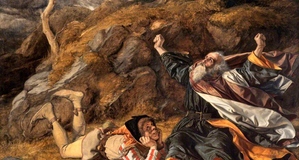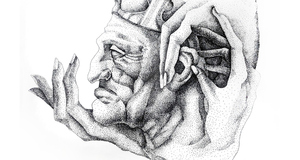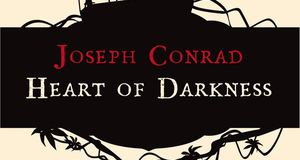"Allows itself to anything:" Poor Tom Familiarizing and Enacting Chaos in King Lear
By
2009, Vol. 1 No. 10 | pg. 1/1
KEYWORDS:
In Shakespeare’s King Lear, Poor Tom—a figure of madness, poverty, and linguistic play—acts as the personification of the semi-apocalyptic state into which the social world of the play descends. Edgar first appears fully as Poor Tom in Act 3, in the midst of the storm, when Lear’s madness becomes fully displayed. That we encounter Poor Tom in the setting of the storm-addled heath associates him with the tempest, but in fact this association is suggested by the text from the very first introduction of the Poor Tom persona. In Act 1, scene 2, Edmund responds to Edgar’s entrance with the following: “Pat he comes, like the catastrophe of the old comedy. My cue is villainous melancholy, with a sigh like Tom o’Bedlam. –O, these eclipses do portend these divisions. Fa, sol, la, mi.” (134-137) Edmund’s introduction of the Tom o’Bedlam character is preceded by his disparagement of astrological superstitions, which he then performs for Edmund as if in the voice of Tom o’Bedlam. Thus these lines create an association between the Tom o’Bedlam figure and a belief in astrological significance. The language of “planetary influence” (125) in Edmund’s speech immediately before Edgar appears establishes a theme of imagery relating to the natural world, the heavens, and weather. According to R.A. Foakes, the term “catastrophe” refers here to an “arbitrary or contrived denouement as in old fashioned comedy,” but the word also suggests a natural disaster, such as a storm (n. 134). Following this possible image of a catastrophe in nature, “villainous melancholy” and “sigh” further suggest a connection between the Tom o’Bedlam figure and the natural world.In the speech in which Edgar engenders the idea to disguise himself as Poor Tom, he seems to pluck the character of the bedlam out of the very landscape:
Following Edgar’s mention of “the winds” and “the sky,” the term “the country” serves as the third item in this series of natural elements. Thus “the country” appears to refer not just to the rural countryside as distinct from the court, or to the country as a political entity, but to the very earth and landscape itself. It is “the country” which provides Edgar with the “proof and precedent” of the Bedlam beggar—the beggar character seems to appear to Edgar from within the physical surroundings. This positions the Poor Tom character that Edgar creates as a natural element of the heath. Furthermore, the “roaring voices” of the beggars suggests the howling winds of the storm to come. Edgar’s language also evokes an image of him taking the natural world onto and into himself: he plans to “grime” his face “with filth,” taking up the dirt and refuse of the earth and covering himself with it. Edgar imagines Bedlam beggars who in a literal sense internalize the outside world by striking “pins, wooden pricks, nails, sprigs of rosemary” into their own bodies. In Edgar’s conception of the bedlam beggar, then, there is little division between a beggar’s own body and the world around that body—the distinction between self and other fades (“Edgar I nothing am” [2.2.192]). These linguistic associations between the Poor Tom figure and the forces of nature and the landscape become increasingly symbolically significant as the natural world takes on a more explicit role in the play. When Lear, the Fool, and Kent encounter the disguised Edgar in 3.4, they find him already within the hovel on the heath. While the audience witnesses the arrival of Lear, Fool, and Kent at this place, no such explanatory moment of arrival is provided for Edgar. Thus the audience, like the characters within the play, encounters “Poor Tom” as a feature of the storm landscape. Just after a speech by Lear in which he apostrophizes to “poor naked wretches […] That bide the pelting of this pitiless storm” (28-29), Poor Tom appears, as if with his words Lear has just conjured up an actual “poor naked wretch,” and Lear’s phrasing recalls Edgar’s vow to “outface the winds and persecutions of the sky.” Edgar’s language as Poor Tom continues the association between the Poor Tom figure and the storm and heath landscape. His first line spoken as Poor Tom is “Fathom and half, fathom and half: Poor Tom!” (27-28) Foakes’ explanation of this line is that “Edgar calls as if he were taking soundings from a boat, or measuring the depth of water in the ‘hovel’” (n. 37). Edgar first speaks as Poor Tom as though surrounded by water. The phrasing of this line suggests danger, as the word “poor” seems to be an adjective applied to Tom in reaction to the “Fathom and half”; it is not until the Fool answers Kent’s query of “Who’s there?” by saying, “A spirit, a spirit. He says his name’s Poor Tom” that the audience is told that “poor” is in fact part of his proper name for himself. In this first line by Edgar-as-Poor-Tom, he associates himself with water and distress, very much mirroring the raging storm which so distresses King Lear. The storm on the heath reflects, among other things, the chaos in the social world of the play and the increasing instability of Lear’s reason; as the play frames Poor Tom in terms recalling the storm, he too becomes a symbol of madness, both social and mental. With his seemingly nonsensical language—“Still through the hawthorn blows the cold wind, says sum, mun, nonny, Dauphin my boy, my boy, cessez! Let him trot by” (3.4.96)—Tom represents the disruption of the natural order caused by the actions of Goneril, Regan, Lear, and Edmund; he is a personification of chaos and fear. But the connection between the natural world and the Poor Tom figure in some ways stabilizes the chaos he represents by localizing it within the landscape; furthermore, as the personification of catastrophe, Poor Tom familiarizes the apocalyptic storm world of the heath by locating chaos within a contained, identifiable persona. In creating his Poor Tom identity, Edgar follows the “proof and precedent” of the Bedlam beggars; he appeals to a pre-existing character type, “the bedlam” which he implies has certain recognizable, traditional elements. While the actions of these beggars are disturbing and desperate—“[striking] in their numbed and mortified bare arms / Pins, wooden pricks, nails, sprigs of rosemary”—these actions are also apparently familiar to Edgar, who is able to recall and then reenact them himself. Edgar’s speech suggests that the “Bedlam beggar” is a familiar persona type in the world of the play. At the end of Act 3, in the aftermath of the blinding of Gloucester, one servant suggests to another, “Let’s follow the old Earl and get the bedlam / To lead him where he would. His roguish madness / Allows itself to anything” (7.102-104). The pairing of the phrases “follow the old Earl” and “get the bedlam” suggests that “the bedlam” refers to a specific individual, just as “the old Earl” does. The familiarity with the general persona type of a Bedlam beggar which Edgar displayed in Act 2 has now shifted to a familiarity with an actual person. These lines suggest that Edgar has already managed to make himself a presence which is known to the servants. “The bedlam” has become an identifiable and familiar element of the storm-addled heath world. As such, “the bedlam” performs a stabilizing function, as the servants assume they will be able to locate him, and that he will follow their plans and support Gloucester. In the chaos of the storm, “the bedlam” here provides the stability of the familiar. Poor Tom acts as a stabilizing agent in two ways: by localizing the chaos of the storm-world in a contained personification, and by providing the stability of the familiar. Counteracting this stabilizing function, however, is the confusion and potential loss of identity which the Poor Tom figure represents. The complexity and ambiguity of identity associated with Poor Tom manifests itself within the text linguistically: the use of pronouns and titles are especially confusing in the lines dealing with Poor Tom, as if the chaos which “the bedlam” represents has bled outward, disrupting the clear connection between the linguistic representation of a person in the form of a pronoun, name, or title, and the physical reality of a person. While the servant in 3.7 seems to refer to a specific individual, the title “the bedlam” is a disturbing instance of synecdoche, referring to the particular by the general term of the Bedlam asylum. The title “the bedlam” emphasizes the connection to the asylum, almost as if that place—with all of the associated violence, madness, and fear—as become personified in one figure, let loose on the heath. The servant’s plan to “get the bedlam” to lead the blind Gloucester appears much more distressing if “the bedlam” refers not to a familiar individual but to any member of the ubiquitous group of bedlam beggars. The synecdoche of “the bedlam” in these lines resonates with the lack of stability which arises from the disturbing sense in which Act 3 seems really to replace the general—“Poor Tom”—for the particular—“Edgar.” The audience’s awareness of Poor Tom’s double level of identity is what allows the irony of Lear’s lines, “Is man no more than this?” (4.101) and “Thou art the thing itself” (4.104). The audience is aware of the reality that Tom actually is “more than this,” because he is really Edgar, the heir to Gloucester; he is not “the thing itself,” as he is only a bedlam beggar in appearance and performance. However, there is an uncomfortable sense at this moment that Edgar really is the thing—the bedlam—itself. At this point in the narrative of the play, Edgar has been disowned and disinherited by his father, leaving him destitute and hunted. Furthermore, while Edgar may be performing the madness of Poor Tom, in a physical sense he is out in the midst of the storm unprotected, reduced to sheltering in a hovel—he is “a poor, bare, forked animal,” as Lear states (4.106). In fact, Lear’s description of Poor Tom as “forked” resonates on two levels: Poor Tom is “forked” in that he has “the lower half of the body divided” and is “two-legged” (OED), but also because his identity is split between Edgar and Poor Tom, but still connected as part of the same entity. Edgar’s slippery relation to his own identity and disguise compounds this understanding of Tom as both “more than this” and as “the thing itself.” Consider the shifts in how Edgar refers to himself:
When Edgar begins these lines by asking, “Who gives anything to Poor Tom?” the audience understands that he is referring to himself, because the Fool as just said that this character calls himself Poor Tom. However, in using the proper name—which is, in itself, a generic name: “a name commonly taken by a beggar who claimed to have come from Bedlam, or Bethlehem Hospital for the insane in London” (n. 135)—Edgar could plausibly be discussing someone other than himself. This is especially possible given Lear’s preceding line, “Didst thou give all to thy two daughters? And art thou come to this?” Lear’s question concerns what the character of Poor Tom gave away, but Edgar’s reply, “Who gives anything to Poor Tom?” does not answer that question. Through the majority of these lines by Edgar, he uses third person pronouns (“his pillow,” “his pew,” “his porridge,” “made him proud,” “his own shadow”). The use of the third person heightens the impression of Edgar’s feigned madness as Poor Tom, participating in the nonsensical language. Again, while this passage appears as Poor Tom speaking about himself, the use of the third person adds another level of complexity. This can be read not just as Edgar-as-Tom speaking about himself in the third person, but also as Edgar, as himself, speaking about the character of Poor Tom which he has created. These separate levels of Edgar’s identification as Poor Tom conflate at the end of these lines, when Edgar’s narrative voice switches to first person: “There could I have him now.” The shifting pronouns in Edgar’s lines suggest a confusion of identity, in which the relationship between Edgar’s identity as himself and his created identity as Poor Tom functions more as a mutable connection rather than a division. When Edgar first appears fully as Poor Tom, Kent asks, “What art thou that dost grumble there I’the straw? Come forth” (3.4.43-44). Kent here uses the interrogative pronoun “what,” connecting with the Fool’s exclamation about “a spirit” and indicating fearfulness. It is interesting that the pronoun used is “what,” and not “who”. The Fool has just informed Kent that the figure in the straw “says his name is Poor Tom,” attributing to unidentified figure in the straw both the capacity for language and a proper name. The shift from a third person possessive subject pronoun—“his”—to the object interrogative pronoun—“what”—creates a confusion even at the level of Poor Tom’s humanity. This chaos of identity seems to follow the figure of Poor Tom linguistically throughout the text. In the servant’s lines in 3.7.102-104, the pronouns contribute to the structure of imagery of a world turned topsy-turvy. In the phrase, “to lead him where he would,” the “him” refers to Gloucester—the “old Earl”—who has just been blinded, and is thus in need of a guide. But in the following phrase, “where he would,” “he” could refer to either Gloucester or to “the bedlam.” These two possibilities produce very different readings. If the “he” is Gloucester, then the servant’s intent appears to be to facilitate Gloucester’s wishes by securing a reliable guide. In this reading, “the bedlam” would only physically lead Gloucester, but would in a sense be following Gloucester’s direction. If, however, the “he” refers to “the bedlam,” this sentence becomes more ominous, as it suggests that Gloucester would entirely be following “the bedlam.” The same ambiguity rests in the next phrase, “His roguish madness / Allows itself to anything.” That the madness is described as “roguish” suggests that the subject is “the bedlam,” as “roguish” seems to fit with the image of a Bedlam Beggar described by Edgar earlier in the play. While this may well be the case, this sentence could plausibly be a description of Gloucester as well. After the horror of the scene leading up to these lines, a servant identifying “madness” in Gloucester does not seem problematic. The phrase “allows itself to anything” recalls the abundant repetitions of “nothing” and nothingness throughout the text (Lear and Cordelia in 1.1, Edmund and Gloucester in 1.2, the Fool in 1.4, Kent in 2.2, etc.). Here, “anything” appears in a phrase that connotes nothingness—“he” (whether Gloucester or the bedlam) will do anything, because “he” has no rationality. This association with the discourse of nothingness seems especially powerful if the subject is Gloucester, supplementing the link between Gloucester and Lear; furthermore, because the phrase “allows itself to anything” indicates a state of despair which hints at suicide, a state which Gloucester will indeed enter in Act 4. Furthermore, these slippery pronouns are associated with a figure of madness and a figure of blindness, leading each other. This sense of ambiguity produces a sort of equivalence between the blind Gloucester and the mad bedlam; with this equivalence, these lines resonate with a passage from the Bible: “Let them alone: they be blind leaders of the blind. And if the blind lead the blind, both shall fall into the ditch” (Matthew 15:14). It is exactly the nature of “the bedlam’s” madness which “allows itself to anything” that manifests itself textually in these frequent confusions—or multiple possibilities, as in this instance—of identity. These ambiguous pronouns enact the shifting and overturning of hierarchies within the social world of the play. “The bedlam,” the Poor Tom figure, personifies this semi-apocalyptic chaos, familiarizing and containing but also enacting that chaos through frequently creating confusions of identity. Edgar-as-Poor-Tom functions as a de-stabilizing figure through another confusion of identity, achieved through mistaken identification rather than ambiguous pronoun use. When Lear first encounters Poor Tom, he addresses him, “Didst thou give all to thy two daughters? And art thou come to this?” (3.4.48-49) Lear’s insistence throughout this scene on attributing Poor Tom’s situation to ungrateful daughters creates the impression of Lear’s madness, as he seems not only unwilling but unable to separate his own misfortune and identity from Poor Tom:
Edgar-as-Tom does not directly answer Lear’s question the first time; Lear then shifts from directing the question to Poor Tom—“Didst thou give all…art thou come to this?”—to asking either rhetorically, or to the Fool and Kent, “Have his daughters brought him to this pass?” Lear then returns again to the direct address of Poor Tom with “thou,” conveying the obsessive repetition of this idea within Lear’s consciousness. As Foakes observes, “a poor naked wretch suddenly appears, and Lear projects on to him his own grievances” (n. 48). Lear locates the source of Poor Tom’s misfortune within Lear’s own personal misery. This passage exemplifies the Poor Tom figure’s contrasting functions as a locus of stability and an agent of chaos. Poor Tom heightens Lear’s descent into madness, as here Lear aligns and confuses his own identity with that of Poor Tom. Lear refuses to believe Kent’s assertion that Poor Tom has no daughters, and in response Kent’s contradiction of Lear, Lear labels him a traitor and threatens him with death. This moment echoes Kent’s attempt to intervene during the love test in Act 1, in which Lear warns, “Kent, on thy life, no more,” (1.1.155) and ultimately banishes Kent, making him a traitor. Echoing 1.1, this moment recalls the original source of chaos within the play, Lear’s banishment of Kent and Cordelia and the success of Goneril and Regan. Thus the Poor Tom figure prompts this resurrection of chaos, by causing Lear to re-enact one of his earliest disastrous mistakes. However, in an odd way these lines are also a moment of clarity for King Lear, in which Poor Tom inspires Lear to “see better” (1.1.159). At this point in the play, the disguised Kent’s true identity remains hidden from Lear and those around him. Thus Lear’s address to Kent as “traitor” is an eerie moment of correct identification within the chaos of identities. And while this is not the meaning of Lear’s lines, “nothing” is, in a way, what “subdued nature to such lowness”; Cordelia’s answer to the love test in 1.1—“Nothing”—surely “reduced [Lear’s] vital powers” (n.69), and precipitated the chain of events that have brought Lear “to such lowness.” Poor Tom’s appearance prompts this moment of unintentional (and, importantly, unacknowledged) lucidity in Lear. Yet even these moments of clarity do not counteract the tragic impact of the contrast between the feigned, nonsensical madness of Poor Tom and the fixated, increasingly real madness of Lear. The figure of Poor Tom in this way “allows itself to anything,” as he performs often contrary functions. “The bedlam” character personifies madness, distress, and the overturning of hierarchies, but it is also this very personification which allows Poor Tom to familiarize the chaos by locating it within a contained individual. The text suggests, however, that the force of chaos and disorder that Poor Tom represents cannot remain fully contained, as the language surrounding Poor Tom abounds with ambiguity. Edgar originally conceives of the Bedlam beggar as one whose identity is not clearly defined from the outside world, and as Poor Tom, he experiences that sense of a confusion of self both in his own relationship to his disguise, and in the characters that he encounters. The Poor Tom figure stabilizes the chaotic storm world by appearing as a natural element of it, one which can be located and follows the expected trope of behavior of a generic bedlam beggar. At the same time, within King Lear Poor Tom also highlights Lear’s insanity, Edgar’s loss of self, and the illusory nature of identity in general, thus enacting the chaos which personifies. William Shakespeare. King Lear. Ed. R.A. Foakes, London: Arden Shakespeare, 1997. Unless otherwise indicated, all references to the play will employ this Arden edition. Suggested Reading from Inquiries Journal
Inquiries Journal provides undergraduate and graduate students around the world a platform for the wide dissemination of academic work over a range of core disciplines. Representing the work of students from hundreds of institutions around the globe, Inquiries Journal's large database of academic articles is completely free. Learn more | Blog | Submit Latest in Literature |


















